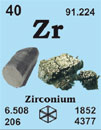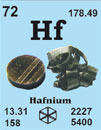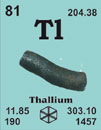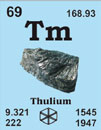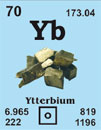Caesium 55Cs132.905
1860 von R. Bunsen und G.R. Kirchhoff in Heidelberg, Deutschland, entdeckt.
[Latin, caesius = himmelblau]
French: césium
English: Caesium/ Cesium
Italian: cesio
Spanish: cesio
Beschreibung: Weiches, glänzendes, goldfarbiges Metall, reagiert schnell mit Sauerstoff und explosiv mit Wasser. Verwendung für Katalysatoren als Promotor, in Spezialgläsern und in Strahlungswarnanlagen.
Further Materials properties
| Crystal structure: |
(cell dimensions/pm), space group,
b.c.c. (78 K) (a=614), Im3m
High pressure forms: (a= 598.4), Fm3m; (a=580.0), Fm3m |
|---|
| X-ray diffractions mass absorption coefficients: |
CuKa 318 (µ/r) / cm2g-1
MoKa 41.3 (µ/r) / cm2g-1 |
|---|
| Neutron scattering length: |
0.542 b/10-12 cm |
|---|
| Thermal neutron capture cross-section: |
29 sa / barns |
|---|
| Density: |
1873 kg/m-3 [293 K]; 1843[liquid at m.p.] |
|---|
| Melting point: |
28.4°C / 301,55°K |
|---|
| Boiling point: |
678.45°C / 951.6°K |
|---|
| Molar volume: |
70.96 cm3 |
|---|
| Thermal conductivity: |
35.9 [300 K] W m-1K-1 |
|---|
| Coefficient of linear thermal expansion: |
97 x 10-6 K-1 |
|---|
| Electrical resistivity: |
20.0 x 10-8 [293 K] Ωm |
|---|
| Mass magnetic susceptibility: |
+2.8 x 10-8(s) kg-1m3 |
|---|
| Young's modulus: |
1.7 GPa |
|---|
| Rigidity modulus: |
0.65 GPa |
|---|
| Bulk modulus: |
n.a. |
|---|
| Poisson's ratio: |
0.295 GPa |
|---|
| Radi: |
Cs+ 165; atomic 265.4; covalent 235; van der Waals 262 |
|---|
| Electronegativity: |
0.79 (Pauling); 0.86 (Allred); 2.18 eV (absolute) |
|---|
| Effective nuclear charge: |
2.20 (Slater); 6.36 (Clementi); 8.56 (Froese-Fischer) |
|---|
| Number of Isotopes (incl. nuclear isomers): |
40 |
|---|
| Isotope mass range: |
114 -> 145 |
|---|
Biological data
| Biological role: |
No known biological role, but it may partly replace potassium |
|---|
| Toxicity |
|
|---|
| Toxic intake: |
n.a. but regarded as fairly toxic |
|---|
| Lethal intake: |
LD50 (Cs2CO3, oral, rat) = 2333 mg Kg-1 |
|---|
| Hazards: |
Although similar to potassium, caesium can have serious effects on the body if taken in excess. Rats fed Cs in place of K died after two weeks. 134Cs and 137Cs are dangerous radioactive pollutants which have escaped from nuclear reactors. |
|---|
| Level in humans |
|
|---|
| Blood: |
0.0038 mg dm-3 |
|---|
| Bone: |
0.013 - 0.052 ppm |
|---|
| Liver: |
0.04 - 0.05 ppm |
|---|
| Muscle: |
0.07 - 1.6 ppm |
|---|
| Daily dietary intake: |
0.004 - 0.03 mg |
|---|
Total mass of element in average
[70 kg] person: |
c. 6 mg |
|---|
Geological data
| Minerals: | Few are known |
|---|
| Mineral | Formula | Density | Hardness | Crystal apperance |
|---|
| Cesium kupleskite |
Cs3(Mn,Fe)7(Ti,Nb)2Si8O24.(OH,F)7 |
3.68 |
4 |
tric., dull gold-brown |
| Pollucite |
(Cs,Na)2Al2Si4O12.nH2O |
2.94 |
6.5 |
cub., col., vit. |
| Chief ores: |
pollucite; cesium is also found in lepidolite (see lithium) |
|---|
| World production: |
c. 20 (cesium compounds) tonnes/year |
|---|
| Main mining areas: |
Bernic Lake (Manitoba, Canada), Bikita (Zimbabwe) and South-West Africa |
|---|
| Reserves: |
c. 100 000 (60 000 at Bernic Lake) |
|---|
| Specimen: |
available as small ingots in sealed ampoules. Danger! |
|---|
| Abundances |
|
|---|
| Sun: |
<80 (relative to H = 1 x 1012) |
|---|
| Earth's crust: |
3 ppm |
|---|
| Seawater |
3.0 x 10-4 |
|---|
| Residence time: |
600 000 years |
|---|
| Classification: |
accumulating |
|---|
| Oxidation state: |
I |
|---|
Source: Emsley, J. (1998) The Elements (3rd Edition)
Other sizes and specifications on request

 English
English
 Deutsch
Deutsch








































